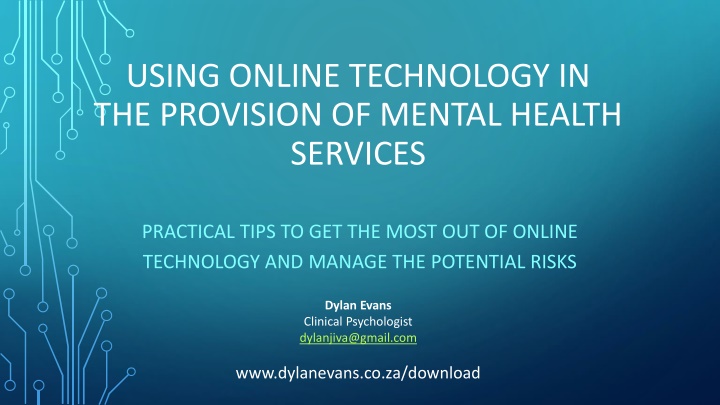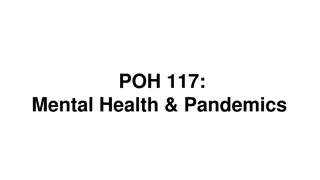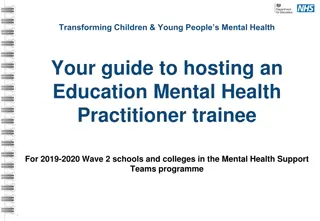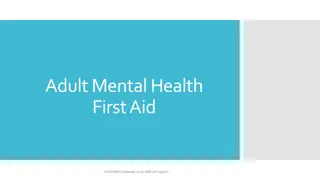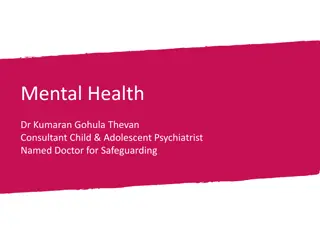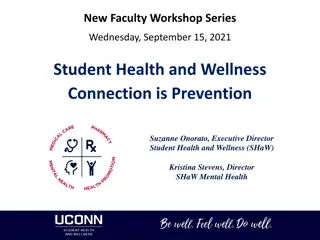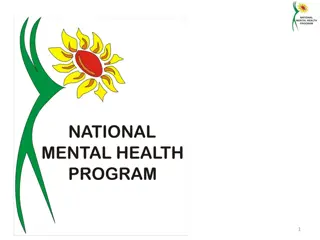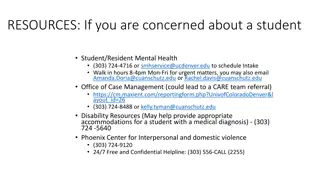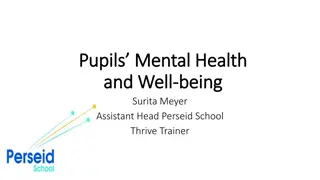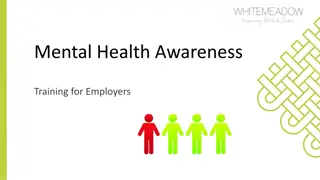Maximizing the Benefits of Online Technology in Mental Health Services
Embracing online technology in mental health services offers convenience, accessibility, and efficiency. Practical tips for utilizing online tools like websites, video conferencing, and social media are essential for effective service delivery. Despite potential risks, research supports the effectiveness of online therapy for various conditions, emphasizing its growing significance in modern mental health practice.
Download Presentation

Please find below an Image/Link to download the presentation.
The content on the website is provided AS IS for your information and personal use only. It may not be sold, licensed, or shared on other websites without obtaining consent from the author.If you encounter any issues during the download, it is possible that the publisher has removed the file from their server.
You are allowed to download the files provided on this website for personal or commercial use, subject to the condition that they are used lawfully. All files are the property of their respective owners.
The content on the website is provided AS IS for your information and personal use only. It may not be sold, licensed, or shared on other websites without obtaining consent from the author.
E N D
Presentation Transcript
USING ONLINE TECHNOLOGY IN THE PROVISION OF MENTAL HEALTH SERVICES PRACTICAL TIPS TO GET THE MOST OUT OF ONLINE TECHNOLOGY AND MANAGE THE POTENTIAL RISKS Dylan Evans Clinical Psychologist dylanjiva@gmail.com www.dylanevans.co.za/download
ONLINE TECHNOLOGY Definition: Use of the internet to mediate the transferral of information and communication between persons. Types: Websites Email Text messaging: Whatsapp, SMS Video/Audio conferencing: Skype, Facetime, Whatsapp Social media: Facebook, Instagram, Twitter Cloud services: Storage (dropbox, iCloud, Onedrive), online applications (Office 365, Google docs) Communication can be: Synchronous where parties communicate in real-time (e.g., video-conferencing) Asynchronous where there are delays in interactions (e.g., email) Non-interactional (e.g., psychoeducational websites).
APPLICATIONS OF ONLINE TECHNOLOGY IN MENTAL HEALTH PRACTICE Administration: Diary management, Billing, Submitting claims, Client notes, Communication with referral sources & clients Advertising: Practice websites, online directories, Google ads, Google Business Therapeutic Applications: Psychoeducation: e.g. Psychcentral.com Diagnostic assessment Therapist delivered treatment via text, audio or video Software delivered treatment: CBT programmes, Virtual reality, mindfulness apps, mood diaries. Peer delivered support: forums, whatsapp group Data storage of client records: Cloud Storage Professional Development: accessing psychological/psychiatric information, online CPD systems
BENEFITS OF ONLINE TECHNOLOGY Convenience Increasing accessibility to services Continuity of services Reducing the stigma of seeking help Potential to reduce resources required to provide treatment Improving efficiency in practice management
RESEARCH ON ONLINE THERAPY There is an emerging research base indicating that online therapy is effective for many conditions, including: Depression: Cowpertwait & Clarke (2013) - Meta-analysis of 18 studies. Showed positive effect moderated by human support and reminders Anxiety: Rees & Maclaine (2015) - Systematic review of 20 studies on video- conferencing showing a moderate to large effect size Substance use disorders: Gainsbury & Blaszczynski (2011) - Systematic review of 9 studies that showed positive treatment effects A recent meta-analysis of 92 studies has even suggested a similar effect size to traditional face-to-face therapy (Barak, Hen, Boniel-Nissim, & Shapira, 2008).
ISSUES WHEN USING ONLINE THERAPY Best interest of the client Competence Technological requirements Confidentiality Professional boundaries Legal and regulatory issues Assessment validity Crisis management Consent
BEST INTERESTS OF THE CLIENT Important to continually assess whether the use of online technology is in the clients best interests NOT the therapist s. Online therapy may be contraindicated if: Client has a high-risk status in terms of suicidality and/or homicidality. Client s current global assessment of functioning is low. Client is not competent in using, or does not have access to, the technology required.
COMPETENCE Mental Health professionals need to be competent in using online technology and have the skills to manage any potential risks posed by the technology. Need to ensure that clients are competent in using the technology required and may need to assist clients to gain the necessary skills.
TECHNOLOGICAL REQUIREMENTS Internet connected device that is able to run the necessary software Broadband internet: Speed: video conferencing 4Mbps connection Data: video conferencing 300-800MB/hr
CONFIDENTIALITY Mental Health professionals should take all reasonable, precautionary efforts to protect and maintain the confidentiality of data/information relating to their clients while using online technology. If they do not, they risk sanction by the HPCSA or by the Information Regulator (appointed through the POPI Act)
POPI ACT Protection of Personal Information (POPI) Act (No. 4 of 2013) Protects the distribution and prevents the abuse of personal information by individuals and corporations. Mental health professionals need to use reasonable security regarding the safeguarding, integrity and confidentiality of personal information of clients.
WAYS CONFIDENTIALITY CAN BE COMPROMISED User level: Tricked into providing information e.g. email pishing Sending to wrong recipient Using device in an environment that is not private Device level: Unauthorised access by another person Virus: software that can record and send data to hacker While information is in transit: snooping While information is on a remote server: hacking
PROTECTING CONFIDENTIALITY User level: keep informed on security threats and be vigilant with any unsolicited emails Verify email addresses before sending information and use confidentiality disclaimer Use devices in a private environment Device level: Password protect your device Encrypt confidential data stored on your device Keep operating system updated Install antivirus software e.g. AVAST Securely delete or even destroy storage media before disposal
PROTECTING CONFIDENTIALITY Transit: Use services that transmit data securely using encryption (HTTPS://) Encrypt sensitive documents before sending them by email Only use secure Wi-Fi networks While information is on a remote server: Check privacy policy of service provider Consider using services that use end-to-end encryption
PASSWORDS ******** Choose secure passwords: Minimum 8 characters that include letters, numbers and special characters. No dictionary words! Use different passwords for different services Use a password manager e.g. Keepass Biometrics: Fingerprint Face detection
ENCRYPT OFFICE DOCUMENT File Protect Document Encrypt with password
CREATE ENCRYPTED PDF IN WORD File Save As Save as type: PDF Tools Encrypt with password
OTHER FILE ENCRYPTION SOFTWARE Axcrypt: http://www.axantum.com/AxCrypt/LegacyD ownloads.html 7-zip can be used to encrypt files: https://www.7-zip.org/
ENCRYPTION LEVELS IN DIFFERENT ONLINE SERVICES Whatsapp: end to end encrypted Facetime, iMessage: end to end encrypted Skype: Encrypted in transit but not end to end Gmail & most email services: Encrypted in transit but not end to end Doxy (doxy.me): free video telemedicine solution that works through browser. End to end encrypted Vsee (vsee.com): similar to skype but end to end encrypted
ELECTRONIC CLIENT RECORDS Simplest: WORD Powerful: ONENOTE Password protected notes Synced to the cloud Available on all platforms Able to easily insert scanned documents
CLIENT RECORD STORAGE Keeping client records in electronic format is convenient and becoming more common Restrict access to protect confidentiality Ethical duties: Storage for period of not less than six years as from the date they became dormant Encrypt any client notes and reports with passwords Management: Backup records to external source in different location
HARD DRIVE SURVIVAL RATE Study of 25 000 hard drives: 90% survive for 3 years, 80% for 4 years Backup, backup, backup!
CLOUD VS. LOCAL STORAGE Local Storage Cloud Storage Pros You have 100 percent control over the data. Very affordable, especially for large amounts of data. No internet connection required. Available anywhere there s an internet connection Hardware stored in secure data centres with multiple protection systems and backups Synchronises different devices Cons Media regularly fails. Easy to forget to backup Possible theft No data access on-the-go Internet connection required. Third party handles your data. Often can be more expensive if you need to store large amounts of data. For cloud storage encrypting data with a password provides extra security
PROFESSIONAL BOUNDARIES Internet is a space where anything goes, accountability is often reduced, where anyone, regardless of training can offer services. Need for mental health professionals to maintain their professional standards when using this medium and maintain appropriate professional boundaries. To keep these boundaries: Maintain the same level of professionalism regardless of the communication medium used. Enable clients to verify professional registration and assess their expertise. Communicate the limits of their availability (e.g., working hours) Negotiate the purposes that different communication mediums can be used for (e.g., email for admin and video-conferencing for therapy) Clarify the anticipated response times when using asynchronous communication mediums.
SOCIAL MEDIA: ETHICAL ISSUES Confidentiality Self Disclosure Professionalism Boundaries: Dual relationships
SOCIAL NETWORKING MANAGEMENT Always assume that whatever you post is public and permanent Set privacy settings so that people who are not friends cannot find you. Never use social media to vent about the challenges of our job or otherwise objectify those who seek our care. Be careful of sharing articles that could be seen as giving advice without an assessment Avoid befriending clients on social media platforms. Create a separate professional Fan Page , however this still has confidentiality implications? Some suggest a social media policy with clients
FACEBOOK PRIVACY https://www.facebook.com/settings?tab=privacy
WHATSAPP Potential issues: Self disclosure: Status updates and photos Blurs boundaries: expectations of instant responses and continual availability Time stamps and blue ticks can be emotionally loaded for clients
WHATSAPP PRIVACY SETTTINGS Settings > Account > Privacy Settings to consider changing: Last seen Status Read receipts
LEGAL AND REGULATORY ISSUES If online treatment takes place across jurisdictional or international boundaries then what legal recourse is available? Need to make clients aware that any legal recourse will need to take place through the HPCSA. Psychologists should enable clients to verify their professional registration: http://isystems.hpcsa.co.za/iregister/
FINANCIAL ARRANGEMENTS Online therapy may differ from traditional mental health services in terms of how services are structured: By time By interactions e.g. email Mental Health professionals should therefore make a special effort to explain all the charges for different services before service provision starts. Mental Health professionals should arrange for secure payment methods for any services provided e.g. Paypal, EFT, Zapper etc.
ONLINE ASSESSMENT When using assessments online Mental Health professionals need to ensure that: the integrity of the psychometric properties of the test (e.g., reliability and validity) the conditions of administration indicated in the test manual are preserved. There are risks associated with unsupervised test administration: Interuptions and distractions Difficulties verifying that the actual client completed the test, without assistance from a third party and without accessing online information about the test. Increased risk of test materials entering the public domain.
CRISES MANAGEMENT Difficulties can arise in managing emergency situations (e.g., suicidality): Clients are not in the same location as the psychologist They can easily cut communucation and go off the radar Mental Health professionals should therefore prepare for future emergency situations by: Developing a crisis support plan collaboratively with their client. Obtain the contact details of a local friend or family member Obtain the contact details of a local medical practitioner Etablishing which methods of communication should be used in an emergency
CONSENT Mental Health professionals should obtain and document informed consent that specifically addresses the unique concerns related to the online services they provide. Specific information should be provided about: The increased risks to confidentiality and how these risks can be mitigated. The technology and skills required to access services. The structure and timing of services provided. The charges billed for specific services. Crisis management strategies. Need to verify the identity and age of prospective clients to check whether they can consent. If the client is under 12 years, consent of a parent/guardian is needed.
ONLINE ADVERTISING Practice Websites, Therapist Directories, Google Ads, Google business HPCSA guidelines: Not unprofessional: how do you define this in terms of websites? Not untruthful, deceptive. No touting: would targeted internet advertising count as touting? Be careful about how you describe yourself and your services: Cannot say specialising in ... Can say areas of practice or services offered .. Use the HPCSA categories and designations. Not "child psychologist" as there is no such category. Can only use descriptions that are factual and can be verified.
REFERENCES Barak, A., Hen, L., Boniel-Nissim, M., & Shapira, N. (2008). A comprehensive review and a meta-analysis of the effectiveness of Internet-based psychotherapeutic interventions. Journal of Technology in Human Services, 26(2-4), 109- 160 Cowpertwait, L., & Clarke, D. (2013). Effectiveness of web-based psychological interventions for depression: A meta- analysis. International Journal of Mental Health and Addiction, 11, 247 268. Evans, D.J. (2014). South African psychologists use of the Internet in their practices. South African Journal of Psychology, 44(2), pp. 62-169. Evans, D.J. (2018). Some guidelines for telepsychology in South Africa. South African Journal of Psychology, 48(2), pp.166 - 170. Gainsbury, S., & Blaszczynski, A. (2011). A systematic review of Internet-based therapy for the treatment of addictions. Clinical Psychology Review, 31, 490 498. Rees, C. S., & Maclaine, E. (2015). A systematic review of videoconference-delivered psychological treatment for anxiety disorders. Australian Psychologist, 50, 259 264.
